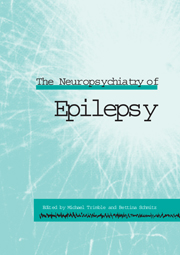Book contents
- Frontmatter
- Contents
- List of contributors
- Part I Background
- Part II Clinical aspects
- 4 The psychiatry of idiopathic generalized epilepsy
- 5 Epilepsy and learning disorders
- 6 Subtle cognitive and behavioural effects of epilepsy
- 7 Aggression and epilepsy
- 8 Epilepsy and suicide: a neuropsychiatric analysis
- 9 Postictal psychoses, revisited
- Part III Cognitive aspects
- Part IV Nonepileptic attacks
- Part V Treatment complications
- Part VI Treatment
- Index
7 - Aggression and epilepsy
Published online by Cambridge University Press: 05 October 2010
- Frontmatter
- Contents
- List of contributors
- Part I Background
- Part II Clinical aspects
- 4 The psychiatry of idiopathic generalized epilepsy
- 5 Epilepsy and learning disorders
- 6 Subtle cognitive and behavioural effects of epilepsy
- 7 Aggression and epilepsy
- 8 Epilepsy and suicide: a neuropsychiatric analysis
- 9 Postictal psychoses, revisited
- Part III Cognitive aspects
- Part IV Nonepileptic attacks
- Part V Treatment complications
- Part VI Treatment
- Index
Summary
Introduction
Human aggression is an important social and clinical problem (Fenwick, 1986; Saver et al., 1996; Swartz et al., 1998; Trimble, 1996). One difficulty of studying aggression is it phenomenological and probably neurobiological heterogeneity, leading to difficulties in assessment and classification. An important distinction has emerged between the terms violence and aggression. Following Treiman, violence has been defined as forceful infliction of abuse or damage onto another individual or object, but which is not necessarily the result of intentional aggression. In contrast, aggression is considered an offensive action directed toward another individual or object with the intent to harm, threaten or control (Treiman, 1991). But even this distinction leaves researchers with the problem of assessing intentionality, which in clinical practice often is impossible. Therefore, it is important to define phenomenological criteria of the specific behavioural syndrome of interest before embarking on research or discussion into the neurobiology and psychology of aggression.
Classification of aggression
In the animal kingdom aggressive behaviour has been classified according to the context in which it can be observed. Table 7.1 summarizes different subtypes of aggressive behaviour in animals following Moyer (1987). In contrast to animal behaviour, human behaviour is less preformed and it depends less on external cues. Thus a simple transfer of this classification to human aggressive behaviour is not valid (Kalin, 1999).
- Type
- Chapter
- Information
- The Neuropsychiatry of Epilepsy , pp. 81 - 106Publisher: Cambridge University PressPrint publication year: 2002
- 3
- Cited by



